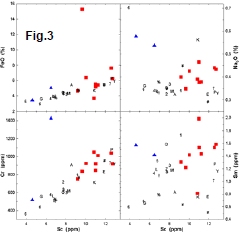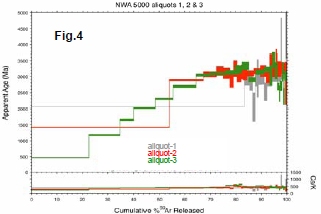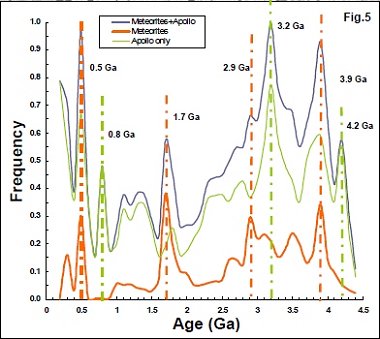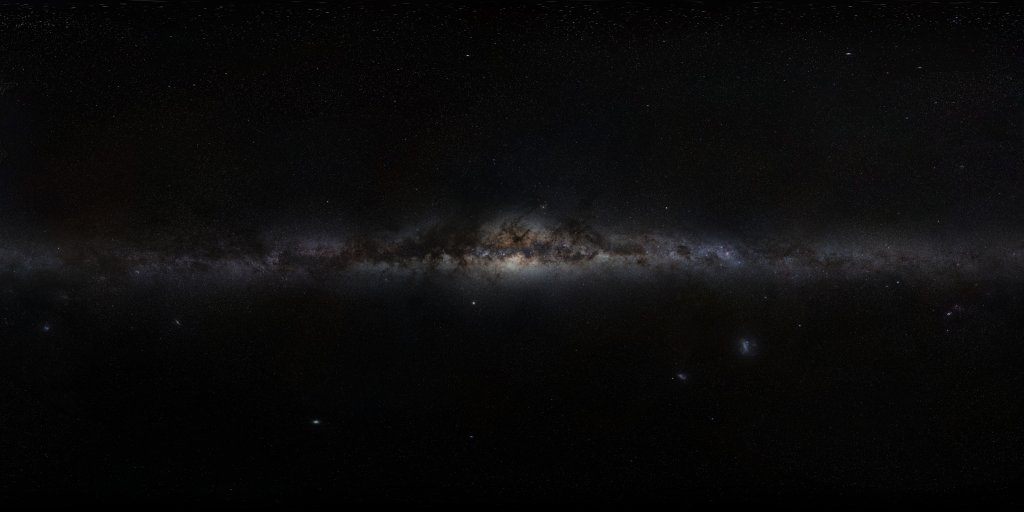| |
Petrology: as described by [1],most clasts consist of coarse grained (0.5-2.7 mm)
calcic plagioclase (An96-98.00rOr<0.1), pigeonite (Fs32-65Wo7-13,
FeO/MnO = 51.1-62.0, some with fine exsolution lamellae) and olivine (Fa24-59, FeO/MnO = 81-100)
with accessory kamacite (up to 2 mm), merrillite, Mg-ilmenite, Ti-chromite, baddeleyite, rare
zirconolite, silica polymorph, K-feldspar and troilite. Some gabbro clasts have shock injection
veins composed mostly of glass with fine troilite blebs and engulfed mineral fragments. Black,
vitreous-appearing clasts consist of sporadic, small angular fragments (apparently surviving relics)
of gabbro and related mineral phases in a very fine grained, non-vesicular matrix of thin pigeonite
laths (up to 20 µm long x 2 µm wide) and interstitial plagioclase with tiny kamacite
spheres, irregular grains of schreibersite and rare troilite.
|

|
Bulk composition: preliminary INAA clast analyses[1], Fig.3 (red squares = gabbro and
matrix subsamples; blue triangles = black impact melt clast; keyboard symbols= other
feldspathic lunar meteorite). gave mean abundances of: (in wt. %) FeO 5.30, Na2O 0.43;
(in ppm) Sc 10.0, Cr 915, Co 19.6, Ni 240, Hf 1.0, Th 0.44, Ba 290, La 3.11, Ce 8.4,
Sm 1.42, Eu 0.89, Tb 0.29, Yb 1.11, Lu 0.156, with considerable scatter. The REE
pattern has a moderate positive Eu anomaly; a grain of apparently igneous metal has
15.4 wt.% FeO, 6060 ppm Ni, 388 ppm Co, 300 ppb Ir and 102 ppb Au (with Ni/Co like in
some irons); the black impact melt clast has higher Na contents [and higher Cr] than
the gabbroic subsamples; this may reflect a sampling effect both in the original
production of shock melt and in modal heterogeneity between subsamples.
|
|
| |
40Ar-39Ar age:40Ar-39Ar spectra for
three bulk subsamples (Fig.4 ) of a gabbroic clast are highly discordant and suggest a
partial re-setting of the K/Ar system manifest in the initial ~70% of the 39
Ar released. This was likely the result of a thermal event such as an impact at ~500 Ma,
and possibly when the material composing this meteorite was excavated and became exposed
on the lunar surface. This interpretation is in agreement with cosmogenic radionuclide
results [3] and also with some petrologic observations suggesting that some of the clasts
were breccias implying multiple impact and mixing events to have affected the leucogabbroic
anorthosite protolith.
|
 |
The last ~30% of 39Ar release shows more consistent apparent ages,
though not meeting standard plateau criteria, suggestive an age of 3.2±0.1 Ga,
possibly the age of the larger impact that created a substantialmelt sheet which then
differentiated. The 38Ar/36Ar for all temperature steps shows
the typical cosmogenic value of ~1.54 indicating negligible contribution from trapped
or solar argon.
|
|
Similar re-setting ages of 3.2-3.3 Ga have been observed for
Apollo 16 soil samples collected from the North Crater ejecta [4-6] and also coincide with
a peak in Apollo 14 [7] impact melt spherule ages, Fig.5.
|

d |
|
2REFS: [1] Irving et al. (2008) 39th LPSC, abst.#2168. [2] Humayun & Irving
(2008) GCA 72, 12S, A402. [3] Nishiizumi et al. (2009) 40th LPSC, abst.# 1476. [4] Fernandes et al.
(2008) Workshop ESSIB, abst.#3028. [5] Shuster et al. (2008) Eos Trans. AGU 89(53), Fall Meet.
Suppl., Abs.# V51H-05. [6] Shuster et al (2009) this conference) [7] Culler et all. (2000)
Science 287, 1785-1788. Acknowledgements: Special thanks to Dr. Tony Irving and Adam Hupé for
making this meteorite available for study.
|
|
|
 |
| |
Goldshcmidt Conference Abstracts 2009 - Page 2: (Click here for Official PDF Version)
|
|
| |
The SP basalt flow: A new primary calibration site for cosmogenic
nuclide production rates
|
|
40Ar-39Ar age for gbbroic lunar
meteorite Northwest Africa 5000
VERA A. FERNADNES
|
|
| |
C.R. FENTON1*, S. NIEDERMANN2 AND M. GOETHALS2
1NERC-CIAF, SUERC, East Kilbride G75 0QF, United
Kingdom (*correspondence: [email protected])
2Helmholtz-Zentrum Potsdam - Deutsches
GeoForschungsZentrum, Potsdam, Germany
([email protected], [email protected])
|
|
Berkeley Geochronology Center, 2455 Ridge Road, Berkeley,
CA 94709, USA ([email protected])
Dept. Earth & Planetary Science, Univ. California, Berkeley,
CA, USA
|
|
| |
The SP lava flow and its cinder cone (SP Crater) are
located in the northern part of the San Francisco volcanic
field, about 55 km north of Flagstaff, AZ (USA). The basaltic
cinder cone and flow both have extremely youthful,
unweathered geomorphic appearances, which retain a welldefined
rim and crater, and lava-flow levee, aa, and
agglutinate features. No soils have formed on the flow, and the
flow surface has a well-developed desert varnish. Previous
studies report 40Ar/39Ar and K-Ar ages of the flow that suggest
the cone erupted 70±4 ka, in contrast to preliminary OSL ages
(~2-4 ka) reported for quartz xenoliths in the same flow.
Preliminary surface exposure data suggest that the flow is
indeed ~70 ka. Co-existing olivine and pyroxene separated
from whole-rock samples collected near the head and at the
toe of the flow were analyzed for cosmogenic 3He and 21Ne.
Fenton et al. [1] report good 1:1 age agreement between these
nuclides in co-existing olivine and pyroxene when using the
following production rates for 3He and 21Ne: 118 and 49
at/g/yr in olivine and 114 and 23 at/g/yr in pyroxene. Using
these rates and measured nuclide concentrations in this study,
preliminary 3He and 21Ne ages of the SP flow yield an average
age (±std. dev) of 68±5 ka. Adjusting these rates to the
specific chemical compositions of SP olivine and pyroxene,
using a modification of Masarik's [2] elemental production
rates, yields an average age (±std. dev) of 70±5 ka, in perfect
agreement with the 40Ar/39Ar and K-Ar ages. The SP flow has
undergone negligible erosion based on initial cosmogenic
nuclide analyses and this is supported by the unweathered
appearance of its surface. This is thus an excellent location for
calibrating production rates of multiple cosmogenic nuclides
in co-existing olivine, pyroxene, and quartz. Based on the
40Ar/39Ar age and 21Ne concentrations in SP pyroxenes, we
already report a weighted-mean production rate (P21Ne) of
25±2 at/g/yr. This agrees with, but is much more precise, than
the P21Ne of 25±8 at/g/yr initially reported by Fenton et al.
[1] Fenton et al. (2009) Quat. Geochron, submitted.
[2] Masarik (2002) Geochim. Cosmochim. Acta 66, A491.
|
|
Lunar meteorite Northwest Africa 5000 is a feldspathic
breccia with predominantly monolithologic composition of
metal-bearing leucogabbroic to gabbroic clasts in a partly
glassy matrix, with some shock melt-injection veins [1]. The
high metal content observed in the clasts has been attributed to
the impactor, suggested to be processed material from the
inner Solar System [2]. The existence of exotic metals within
the otherwise apparently igneous-textured gabbroic clasts may
signify large-scale impact melting and differentiation. Initial
40Ar-39Ar age spectra for three bulk subsamples of a gabbroic
clast are highly discordant and suggest a partial re-setting of
the K/Ar system manifest in the initial ~70% of the 39Ar
released. This was likely the result of a thermal event such as
an impact at ~500 Ma, and possibly when the material
composing this meteorite was excavated and became exposed
on the lunar surface. This interpretation is in agreement with
cosmogenic radionuclide results [3]. The following ~30% of
39Ar release shows more consistent apparent ages, though not
meeting standard plateau criteria, suggestive of an age of
3.2±0.1 Ga, possibly the age of the larger impact that created a
substantial melt sheet which then differentiated. The 38Ar/36Ar
for all temperature steps shows the typical cosmogenic value
of ~1.54 indicating negligible contribution from trapped or
solar argon. Similar re-setting ages of 3.2-3.3 Ga have been
observed for Apollo 16 soil samples collected from the North
Crater ejecta [4,5], and also coincide with a peak in Apollo 14
[6] impact melt spherule ages.
Special thanks to Dr. Tony Irving and Adam Hupé for
making this meteorite available for study.
[1] Irving et al. (2008) 39th LPSC, abst.#2168. [2] Humayun &
Irving (2008) GCA 72, 12S, A402. [3] Nishiizumi et al. (2009)
40th LPSC, abst.# 1476. [4] Fernandes et al. (2008) Workshop
ESSIB, abst.#3028. [5] Shuster et al. (2008) Eos Trans. AGU
89(53) Fall Meet. Suppl., Abs.# V51H-05. [6] Culler et al.
(2000) Science 287, 1785-1788.
|
|
|

